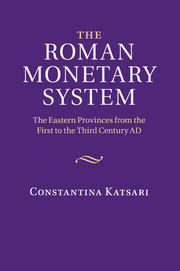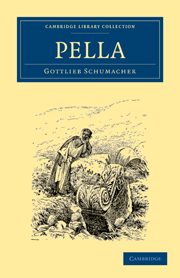Refine search
Actions for selected content:
23990 results in Ancient history
5 - Slavery and economy in the Greek world
-
-
- Book:
- The Cambridge World History of Slavery
- Published online:
- 28 September 2011
- Print publication:
- 07 March 2011, pp 91-111
-
- Chapter
- Export citation
Index of ancient passages cited
-
- Book:
- The Cambridge World History of Slavery
- Published online:
- 28 September 2011
- Print publication:
- 07 March 2011, pp 593-615
-
- Chapter
- Export citation
19 - Slavery and Roman law
-
-
- Book:
- The Cambridge World History of Slavery
- Published online:
- 28 September 2011
- Print publication:
- 07 March 2011, pp 414-437
-
- Chapter
- Export citation
Acknowledgements
-
- Book:
- The Cambridge World History of Slavery
- Published online:
- 28 September 2011
- Print publication:
- 07 March 2011, pp xi-xii
-
- Chapter
- Export citation
8 - Resistance among chattel slaves in the classical Greek world
-
-
- Book:
- The Cambridge World History of Slavery
- Published online:
- 28 September 2011
- Print publication:
- 07 March 2011, pp 153-175
-
- Chapter
- Export citation
Contents
-
- Book:
- The Cambridge World History of Slavery
- Published online:
- 28 September 2011
- Print publication:
- 07 March 2011, pp v-viii
-
- Chapter
- Export citation
13 - Slavery Under the Principate
-
-
- Book:
- The Cambridge World History of Slavery
- Published online:
- 28 September 2011
- Print publication:
- 07 March 2011, pp 265-286
-
- Chapter
- Export citation
22 - Slavery in the late Roman world
-
-
- Book:
- The Cambridge World History of Slavery
- Published online:
- 28 September 2011
- Print publication:
- 07 March 2011, pp 482-509
-
- Chapter
- Export citation
Series editors' introduction
-
- Book:
- The Cambridge World History of Slavery
- Published online:
- 28 September 2011
- Print publication:
- 07 March 2011, pp ix-ix
-
- Chapter
- Export citation
Frontmatter
-
- Book:
- The Cambridge World History of Slavery
- Published online:
- 28 September 2011
- Print publication:
- 07 March 2011, pp i-iv
-
- Chapter
- Export citation
17 - Resisting slavery at Rome
-
-
- Book:
- The Cambridge World History of Slavery
- Published online:
- 28 September 2011
- Print publication:
- 07 March 2011, pp 362-384
-
- Chapter
- Export citation
7 - Slavery and the Greek family
-
-
- Book:
- The Cambridge World History of Slavery
- Published online:
- 28 September 2011
- Print publication:
- 07 March 2011, pp 134-152
-
- Chapter
- Export citation
4 - The Helots: a contemporary review
-
-
- Book:
- The Cambridge World History of Slavery
- Published online:
- 28 September 2011
- Print publication:
- 07 March 2011, pp 74-90
-
- Chapter
- Export citation
15 - Slave labour and Roman society
-
-
- Book:
- The Cambridge World History of Slavery
- Published online:
- 28 September 2011
- Print publication:
- 07 March 2011, pp 311-336
-
- Chapter
- Export citation
21 - Slavery and the rise of Christianity
-
-
- Book:
- The Cambridge World History of Slavery
- Published online:
- 28 September 2011
- Print publication:
- 07 March 2011, pp 456-481
-
- Chapter
- Export citation
2 - Slaves in Greek literary culture
-
-
- Book:
- The Cambridge World History of Slavery
- Published online:
- 28 September 2011
- Print publication:
- 07 March 2011, pp 22-47
-
- Chapter
- Export citation
16 - Slavery and the Roman family
-
-
- Book:
- The Cambridge World History of Slavery
- Published online:
- 28 September 2011
- Print publication:
- 07 March 2011, pp 337-361
-
- Chapter
- Export citation
Index of Jewish and Christian Literature Cited
-
- Book:
- The Cambridge World History of Slavery
- Published online:
- 28 September 2011
- Print publication:
- 07 March 2011, pp 619-620
-
- Chapter
- Export citation

The Roman Monetary System
- The Eastern Provinces from the First to the Third Century AD
-
- Published online:
- 01 March 2011
- Print publication:
- 24 February 2011

Pella
-
- Published online:
- 01 March 2011
- Print publication:
- 19 August 2010
- First published in:
- 1888
